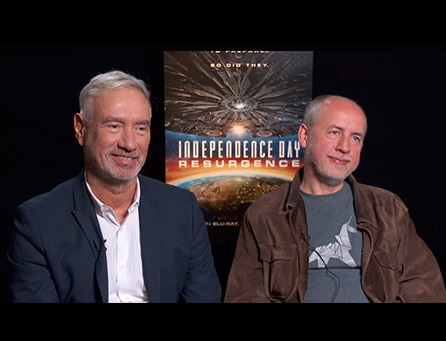Emmerich on How Much Tech Is

In the 20 years between the original Independence Day and the 2016 release of Independence Day Resurgence, director Roland Emmerich (The Day After Tomorrow, Godzilla) has watched the tech behind filmmaking and home entertainment absolutely explode. And he’s not a fan of everything that’s now available for home entertainment audiences.
Emmerich and Volker Engel, visual effects supervisor for Resurgence, sat down with Next TV to talk about the benefits and drawbacks of early digital releases, the demands of today’s consumers to have everything available around a film and whether or not 4K TVs are showing more than content creators intended. An edited transcript of the conversation follows.
NTV: In Independence Day, you were blowing up car models and using miniatures of the Statue of Liberty. That was 1996; for the sequel, 70% of the film was shot on blue screen. How has it become easier, and more difficult, to put together the visuals of a film?
Roland Emmerich: I sometimes miss it, because you had to use ingenuity to create something. On the other hand it was very limiting. Today, you can pretty much do everything. It’s all about how much time and money you have. There’s amazing freedom, but it also makes it very stressful, because the studios expect you to finish this stuff and they don’t see how difficult it really is. It’s a different world, for sure better, but the fun factor is lower.
Volker Engel: The fact that you invent something on the fly, and get something that you didn’t expect would happen, that doesn’t happen anymore. Everything is planned from the beginning, every little step until the very end.
NTV: For a home entertainment release, there’s 3D Blu-ray, 4K, technologies like High Dynamic Range and 60 frames per second. How much is beneficial to the experience and how much of it is a fad?
Emmerich: I sometimes have the feeling that the image on the TV got a little too sharp, because film when it’s on a screen has this light fuzziness, and I always want to ask these companies who make the DVDs and the players and the TVs to maybe put a film filter in, that imitates the feeling you get with a film screen.
Broadcasting & Cable Newsletter
The smarter way to stay on top of broadcasting and cable industry. Sign up below
NTV: On the home entertainment release of Independence Day, we’re getting almost 10 deleted scenes. How do you go through that process and how late in the game do you get to decide?
Emmerich: You can go very late, it’s digital editing, nothing’s analog anymore, and you can go quite fast. It’s mainly a testing process, an endless rewatching process of something you’ve done, to make it clearer, faster and more functional in a way. Editing is the last rewrite you can give your film.
Engel: It’s all about story. It’s never about bigger and better.
NTV: All the major studios are putting films out on digital weeks, sometimes even a month, ahead of the disc release. Are you fans of that model, and is that something you’d like to see more of?
Emmerich: There are discussions about it, and there’s definitely a danger. If you stream [early], the magic of movies gets lost. I’m a big believer in going to a movie theater, watching it there before any other medium is available, because that’s the way it’s supposed to be.
NTV: Are there bonus features you’d point people to first when they buy the disc?
Emmerich: Sometimes I’m a little skeptical: Are we putting too much of the magic on these DVDs, so anybody can educate themselves on how it was done? Is there not some of the magic lost? But on the other hand, people want to have more and more of these things. It’s a trend, where the younger generation wants to know exactly how it was done.
Engel: Then you have the people who are especially interested in it. It’s almost like film school. I wish I would have had something like that 25 years ago.










